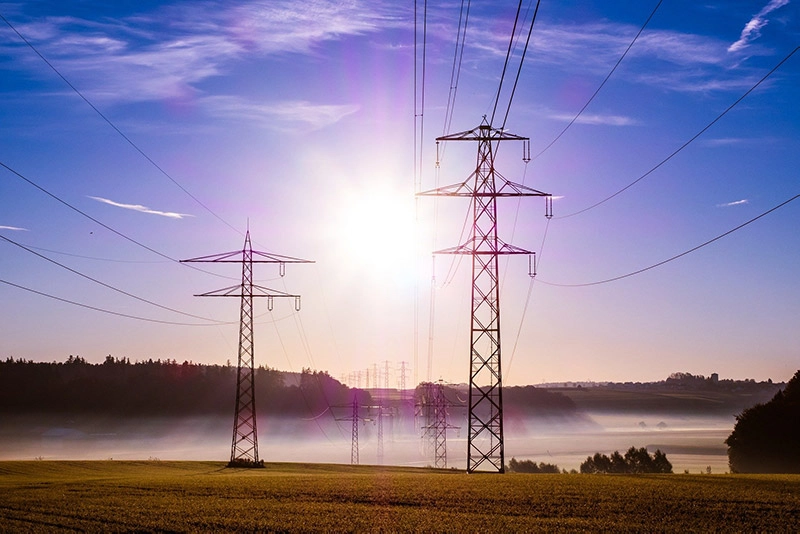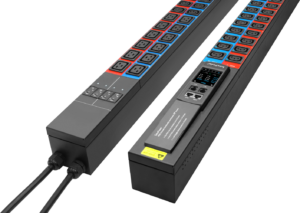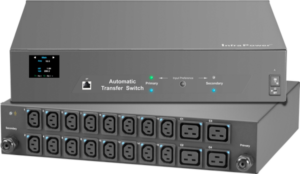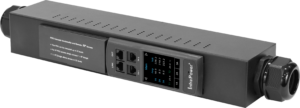Before we can dive into this comparison it is important to note that it only relates to AC Circuits and does not applied to DC circuit because the Sinusoidal waveform comes only in AC Circuits. That out of the way let’s continue on.
The Basics: We can break down power into the following basic categories Active, Reactive, and Apparent Power.
• Active power P, or Watts. Real power is the power consumed or utilized supplied to run a Server or rack device in the AC circuit. In other words it is the real electrical resistance power consumption in circuit.
• Reactive Power Q, or kVAR. While Active power is the energy supplied to run a server, power a UPS, or illuminate an electric light bulb, reactive power provides the important function of regulating voltage. Reactive power is used to provide the voltage levels necessary for active power to do useful work. This is also known as power factor. The lower the power factor or closer to the Active Power the better the efficiency.
• Apparent power S or kVA. kVA is a measure of apparent power: it tells you the total amount of power in use in a system.
• Power Factor Electrical efficiency is expressed as a power factor between 0 and 1: the closer the power factor is to 1, the more efficiently the kVA is being converted into useful kW.
Engineers use the following terms to describe energy flow in a system:
• Active power,[1] P, or real power:[2] watt (W);
• Reactive power, Q: volt-ampere reactive (VAR);
• Complex power, S: volt-ampere (VA);
• Apparent power, |S|: the magnitude of complex power S: volt-ampere (VA);
Phase of voltage relative to current, ϕ: the angle of difference (in degrees) between current and voltage; ϕ = arg(V) – arg(I).
• Current lagging voltage (quadrant I vector), current leading voltage (quadrant IV vector).
These are all denoted in the adjacent diagram (called a Power Triangle): [3]
The formula for converting kVA into kW is:
Apparent power (kVA) x power factor (pf) = actual power (kW)
e.g. 100 kVA x 0.8 = 80 kW
The formula for converting kW into kVA is:
Actual power (kW) / power factor (pf) = apparent power (kVA)
e.g. 100 kW / 0.8 = 125 kVA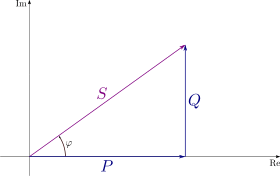
THE BEER ANALOGY
Power Factor (P.F.) is the ratio of Working Power to Apparent Power. Looking at our beer mug analogy above, power factor would be the ratio of beer (KW) to beer plus foam (KVA).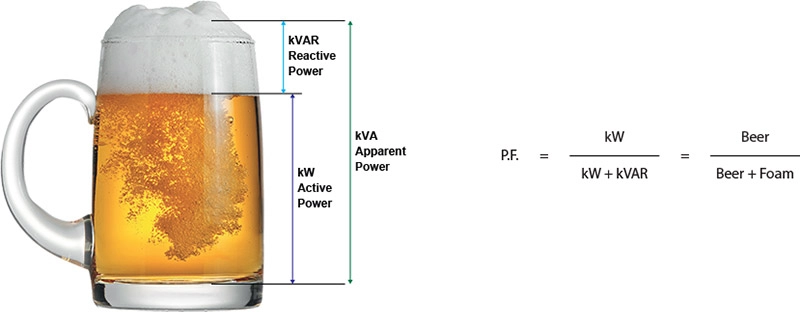
Our PDUs are continually monitoring these calculations automatically allowing you to run your electrical system as optimally as possible.
Tips on Improving Power Factor
• Minimizing operation of idling or lightly loaded servers. Our outlet level monitoring PDUs can monitor server loads by the outlet individually allowing you to find stranded or underloaded capacity.
• Avoiding operation of equipment above its rated voltage. We can help provide you an optimal PDU to assure efficiency and 24 hour monitoring and alerting.
• Replacing older servers with newer energy-efficient ones and monitor with intelligent PDUs. We can provide you technology refresh incentives on all of your legacy power PDU replacements. Efficiency begins at monitoring.
Explore InfraPower Products
Question:
What is the difference between Active Power and Apparent Power?
Before we can dive into this comparison it is important to note that it only relates to AC Circuits and does not applied to DC circuit because the Sinusoidal waveform comes only in AC Circuits. That out of the way let’s continue on.
The Basics: We can break down power into the following basic categories Active, Reactive, and Apparent Power.
- Active power P, or Watts. Real power is the power consumed or utilized supplied to run a Server or rack device in the AC circuit. In other words it is the real electrical resistance power consumption in circuit.
- Reactive Power Q, or kVAR. While Active power is the energy supplied to run a server, power a UPS, or illuminate an electric light bulb, reactive power provides the important function of regulating voltage. Reactive power is used to provide the voltage levels necessary for active power to do useful work. This is also known as power factor. The lower the power factor or closer to the Active Power the better the efficiency.
- Apparent power S or kVA. kVA is a measure of apparent power: it tells you the total amount of power in use in a system.
- Power Factor Electrical efficiency is expressed as a power factor between 0 and 1: the closer the power factor is to 1, the more efficiently the kVA is being converted into useful kW.
Engineers use the following terms to describe energy flow in a system:
Active power,[1] P, or real power:[2] watt (W);
Reactive power, Q: volt-ampere reactive (VAR);
Complex power, S: volt-ampere (VA);
Apparent power, |S|: the magnitude of complex power S: volt-ampere (VA);
Phase of voltage relative to current, ϕ: the angle of difference (in degrees) between current and voltage; ϕ = arg(V) – arg(I).
Current lagging voltage (quadrant I vector), current leading voltage (quadrant IV vector).
These are all denoted in the adjacent diagram (called a Power Triangle): [3]
The formula for converting kVA into kW is:
Apparent power (kVA) x power factor (pf) = actual power (kW)
e.g. 100 kVA x 0.8 = 80 kW
The formula for converting kW into kVA is:
Actual power (kW) / power factor (pf) = apparent power (kVA)
e.g. 100 kW / 0.8 = 125 kVA

THE BEER ANALOGY
Power Factor (P.F.) is the ratio of Working Power to Apparent Power. Looking at our beer mug analogy above, power factor would be the ratio of beer (KW) to beer plus foam (KVA).

Our PDUs are continually monitoring these calculations automatically allowing you to run your electrical system as optimally as possible.
Tips on Improving Power Factor
- Minimizing operation of idling or lightly loaded servers. Our outlet level monitoring PDUs can monitor server loads by the outlet individually allowing you to find stranded or underloaded capacity.
- Avoiding operation of equipment above its rated voltage. We can help provide you an optimal PDU to assure efficiency and 24 hour monitoring and alerting.
- Replacing older servers with newer energy-efficient ones and monitor with intelligent PDUs. We can provide you technology refresh incentives on all of your legacy power PDU replacements. Efficiency begins at monitoring.
Happy Hour Anyone?
Explore InfraPower Products
Company Profile: Austin Hughes
Austin Hughes is a leading edge design and manufacturing group that offers a broad range of active solutions based around 19-inch rack mount technology.
In addition to InfraPower, the Austin Hughes comprehensive range of Power Distribution Units and Automatic Transfer Switches (ATS), Austin Hughes also offers InfraSolution Smart Card Access Control, InfraGuard Environmental Monitoring, CyberView KVM (Keyboard, Video and Mouse), LCD Console Drawers and UltraView professional LCD screens.


